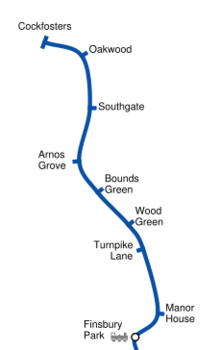Piccadilly line extension to Cockfosters
The Piccadilly line extension to Cockfosters added eight new stations to the northern end of London Underground's Piccadilly line. The extension through north London from Finsbury Park to Cockfosters was opened in three stages between 19 September 1932 and 31 July 1933.
Need
When the Great Northern, Piccadilly and Brompton Railway (GNP&BR, precursor of the Piccadilly line) opened in December 1906, its northern terminus was at Finsbury Park where it had an interchange with the Great Northern Railway (GNR) and the Great Northern & City Railway (GN&CR). To obtain approval for the railway's construction, the GNP&BR had, like the GN&CR before it, had to accept a GNR veto over further extensions north in competition of latter's suburban passenger services from King's Cross.
Very soon after the GNP&BR opened it was clear that the termination of the line in urban Finsbury Park rather than further out of central London in more suburban Wood Green, Southgate or Tottenham had been a mistake. Passengers leaving the GNP&BR and the GN&CR at Finsbury Park preferred to transfer on to trams and buses for the continuation of their journeys, rather than use the GNR as it had hoped. This caused much inconvenience and congestion in and around the station at Finsbury Park.
Solution
Calls for a solution to the congestion at Finsbury Park were frequent almost from the GNP&BR's opening and after the First World War the campaign for extending the line gathered strength. In 1921, the Municipal Borough of Tottenham, sent a resolution to the Government, suggesting the desirability of extending one of the two lines then terminating at Finsbury Park to Seven Sisters Corner. In the face of mounting pressure the London and North Eastern Railway (LNER) continued the opposition of its predecessor, the GNR, to a northward extension of the Piccadilly line although it did begin developing plans for the electrification of its own suburban services.
When the LNER cancelled the electrification of its routes due to lack of money, a petition from the Middlesex Federation of Ratepayers in 1923, finally spurred the government to act and, in 1925, "The North and North-East London Traffic Inquiry" was set up to examine options. When the Inquiry reported, it recommended an extension initially only one station to Manor House. The LNER was placed in the position of either carrying out the electrification of its own services or withdrawing its veto to an extension of the Piccadilly line.
To make the extension financially worthwhile, the Underground Group needed to maximise the number of passengers using it by extending the new route as far as possible to the north and by building as much of it as possible on the surface for which construction is considerably cheaper than in tunnel. A route was proposed out to rural Oakwood and Cockfosters although the Underground Group did not actually have the money to construct even the limited extension to Manor House.
The recession of the late 1920s eventually provided the economic imperative for the construction of the extension. The government introduced the Development (Loan Guarantees and Grants) Act in 1930 which provided government guarantees on loans raised for construction. The aim was to increase employment through a stimulation of public works projects and, with guarantees available on the money needed for the construction, the Underground Group was able to start work on the Cockfosters extension, the Piccadilly line western extension as well as many other projects throughout the Underground network.
All the stations were designed by Charles Holden and colleagues in a modern European style, assembling the buildings from a collection of basic geometric shapes.
Despite the Underground Groups wish to construct most of the extension on the surface, the first four stations are underground. The line surfaces at Arnos Grove before going back into tunnel to pass through a hill at Southgate. North of Southgate, the line is on the surface for the rest of the route to Cockfosters. Therefore, five of the eight stations on the extension are underground.
Stations on the Extension

- Opened on 19 September 1932
- Manor House
- Harringay (St Ann's Road) , proposed but never constructed
- Turnpike Lane, other proposed names; "North Harringay" and "Ducketts Green"
- Wood Green, other proposed names; "Wood Green Central" and "Lordship Lane"
- Bounds Green, other proposed names; "Wood Green North" and "Brownlow Road"
- Arnos Grove, other proposed names; "Arnos Park", "Bowes Road" and "Southgate"
- Opened 13 March 1933
- Southgate, other proposed names; "Chase Side" and "Southgate Central"
- Oakwood, opened as "Enfield West" before changing to "Enfield West (Oakwood)" then in 1946 to its present name. Other proposed names; "Southgate North, Oakwood Park", "Oakwood", "Merryhills" and "East Barnet"
- Opened 31 July 1933
- Cockfosters, other proposed name "Trent Park"
External links
- London Transport Museum Photographic Archive - 1933 promotional map of extension
Further reading
- Christian Wolmar. The Subterranean Railway: How the London Underground Was Built and How It Changed the City Forever. Atlantic Books. pp. 227–231. ISBN 1-84354-023-1.
